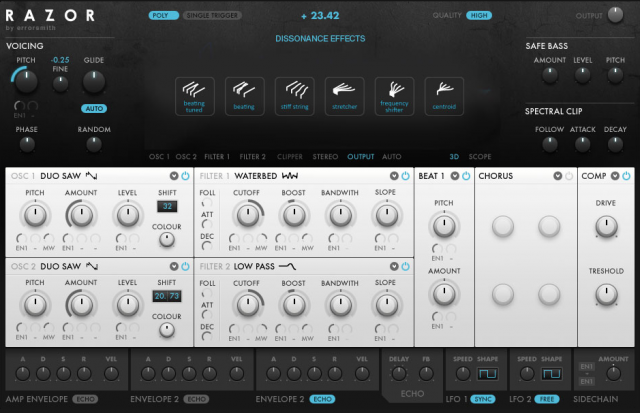Native Instruments has a new synth based on the Reaktor engine, and it’s one about which to be genuinely excited. Taking additive synthesis to a new conceptual level, it works with the concept of per-partial control but adds functions like wavetables, enveloping, and effects to each partial individually. The result is a synth that gets sonically surprising in a hurry, and it represents the sort of multi-dimensional thinking I hope catches on in synthesis.
In a step forward for Reaktor, this synth doesn’t just sound different – it looks different, too. Whereas incredible sonic creations have been hidden too often in software behind banks of bland, faux knobs, Razor’s dynamic spectral display makes both the partials and their transformation in time clear and hypnotically beautiful.
Under the hood, the project packs some 320 partials and internal sound shaping, dual filter sections with 20 filter types, “dissonance effect” modulation, and in case your mind remained somehow unbent, a 34-band vocoder. There’s also a genre-spanning preset library, though the ubiquity of NI tools in Dubstep have caused people to already make that connection. (Fine. Spite them. Go make something that doesn’t sound like any recognizable genre. You have my blessing.)
The software is the result of a collaboration with artist Errorsmith, and represents an ongoing series of artist co-produced software releases from the Berlin-based Native Instruments. For his part, Errorsmith (also part of MMM and Smith n Hack) has been a forward-thinking Berlin staple for many years, and a DIYer at heart, combining just these sorts of modular monsters in his own work. What strikes me is that, working with NI, he’s come up with something that could be widely used. It’s one thing to create a strange creation for yourself, and there’s something even strangely pleasing about making it idiosyncratic. Making a tool that a wide audience can use to vastly-differing results is another matter entirely.
Thanks to advance availability, NI has already got some buzz going around the creation, so we’ve got a tutorial and free loops from our friends to share with you.
Steve Horelick, the man who gave us the Reading Rainbow theme song on his Fairlight CMI and then went on to make Logic Environments that produce otherworldly musical landscapes, has his own take. He walks through the interface one module at a time. Steve does not work for NI – this is what it sounds like when he’s excited about something. Listen closely to what he’s saying, breathlessly, because as always Steve has immediate, sharp insights into what everything’s for and why it matters. If you pay attention, class, you’ll learn something. (Let me say it again: this is someone who finds the Logic Environment intuitive, and can explain it to others. Apologies to Apple and Emagic veterans, but that has to count for something big.)
Updated: In comments, Random Chance does spot two errors in the video – hey, this thing is barely out, so I know it’s easy enough to make mistakes:
The spectrum display does not show the waveform, but rather the real (as in real numbers) spectrum with time as a thrown in as a third axis. And filtering is precisely altering the spectral shape (although you may as well call every signal transducer a filter).
I concur, but otherwise have some patience with Steve’s narrative style (people either hate it or love it), and it’s a solid walkthrough of the modules and why they matter.
Steve also creates training for, and now helms, the massive training site Macprovideo, which in turn has its own blog now, well worth reading:
http://www.macprovideo.com/blog/
Francis Preve, fellow Keyboard writer who just launched his new Academik label last week (I was grateful to be there armed with a laptop and KAOSS Quad to open the celebrations), is prolific as always. He has two posts up on Razor, and also tells CDM he’s got some free loops for you to grab built with Razor:
With its über-pretty FFT display of harmonic motion, tons of really unique filters and a couple of beat-synced LFOs, RAZOR makes a deep cut into additive synthesis territory (sorry, couldn’t resist the pun).
So, I decided to beat everyone to the punch and drop a RAZOR-edged free loop six-pack on ya, so you can get a taste for yourself.
Tech notes and linkage after the jump…
Tech notes:
– Everything’s in the key of C minor-ish.
– All loops are 128 BPM.
– All loops are eight bars long.
Download: NI RAZOR Loop Six-pack [Francis Preve]
Steve Horelick: Francis has a life-sized Yoda figure in his studio, and the force is strong with him. (Seriously.) Synth programming deathmatch, anyone? New York versus Texas?
All in all, that should give you somewhere to start if you’re interested in Razor. I’ll be curious to hear what people do with it. If you’ve got questions you’d like to direct to NI, or if you’d like to hear more about how this instrument was produced, let us know.

